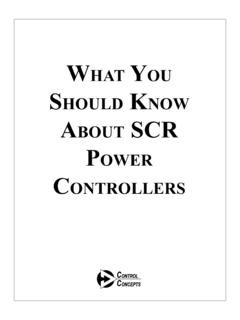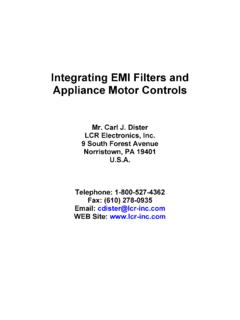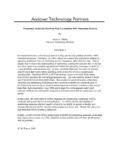Transcription of SCR Power Controllers - heaters-controls-hydraulics.com
1 SCR PowerControllersOperating InstructionsSCR Power CONTROLLERSTABLE OF CONTENTSG eneral Descriptionand and Lists andOrdering INSTRUCTIONSS eries 19 and 39 SCR Power Controllers Series 91 and 93 SCR Power ControllersSection 1. General DescriptionIntroductionAthena's SCR Power Controllers are designed to regulate ac Power to electrical heating processes, such as ovens, furnaces, heatsealers, etc. (Note: They are not designed to drive transformers,coils or other inductive-type loads.) The controller accepts an input signal, such as 4-20 mAdc fromsome signal conditioning device, , an Athena temperature con-troller. For most processes, the combination of an Athena tempera-ture controller and SCR Power controller will provide very accu-rate, automatic temperature control .
2 For manual operation, a man-ual control option with a remote potentiometer is SpecificationsInputs:4-20 mAdc standard, or as ordered (see serial ) minimum voltage requirements 10 Vdc; allinputs electrically isolated via optical couplingSupply Voltage: 110/120; 208/240; 440/480, 575/600 Vac, or as ordered (Phase connection not critical on 3-phase units)Frequency:50/60 HzAmbient Temperature: 30 to 122 F for listed Power ratingsCooling:ConvectionProtection:Sub- cycle, current-limiting fuse; transient voltage suppressionLoad:Resistive, 1- or 3-phase - 3-wire wye or deltaAll specifications subject to 2. Firing ModesZero-Crossing control . A zero-crossing switched (zero-switched or burst-fired) SCRpower controller works by triggering at the moment when thevalue of the ac sine wave is at the baseline or "zero" voltage point(Figure 1).
3 This results in a "burst" of full line voltage with noRFI. Athena's SCR Power Controllers utilize a patented trigger circuit that turns on the SCRs as close as possible to the ac zerovoltage point. Proportioning action is obtained by varying thenumber of cycles on to the number of cycles off. The output willvary from a few cycles on and a large number of cycles off at lowinput, through half the cycles on and half off at half input, to allcycles on at maximum input. This output is integrated by theheaters which produce a smoothly proportioning heat output thatvaries directly with the input SecondTime BaseOnOffFigure 1. Time-proportioned, zero-cross phase-angle type SCR Power controller works by delaying thetrigger pulse to some point in the half cycle of the ac wave.
4 Thistrigger point, from 0 to 180 degrees, is referred to as the phaseangle (Figure 2). The SCR will turn on when triggered, and remainon for the rest of the half cycle. Increasing the control signal willcause the trigger pulse to occur earlier in the half cycle, thus deliv-ering a greater portion of the wave to the 2. Phase-angle changes and their effect on output it provides an extremely fast response, phase-angle control should be used in low-mass element applications thatrequire high switching speeds, such as tungsten elements, quartzlamps, hot wires and other loads subject to high inrush currents.(Note: Some RFI can be generated from the phase angle controller )Athena's SCR phase-angle Power Controllers are available with asoft-start timing option that provides a ramp to peak voltage, andare available with a voltage limit option that "clamps" output voltage to a level lower than the supply angle = 113 , 293 Power = 25%0 360 180 11 3 293 Section 3.
5 MountingMount the controller , with the heat sinks in a vertical position, in areasonably cool location -- 50 C (122 F) maximum. Some spaceshould be left above and below the unit to allow for air the controller must be placed in an environment where the ambi-ent temperature exceeds 50 C (122 F), it will be necessary to derate the unit. If derating is not possible, venting or an exhaustfan must be used to keep ambient temperatures at an acceptablelevel. (See Figure 3 for cooling calculations).Formula for minimum metal enclosure size for convection x AMPS x # of Controlled Legs Min Exposed122 F - Ambient F =Sq. x AMPS x # of Controlled Legs Min. Exposed50 C - Ambient C =Sq. for forced air x AMPS x # of Controlled Legs50 C -Ambient C = Min.
6 X AMPS x # of Controlled Legs122 F - Ambient F =Min. CFM4 Figure 3. Calculations for determining cooling WiringThe wiring components of Athena's SCR Power Controllers consist of line voltage, heater load, and signal input. Follow thewiring diagrams on the following pages (Figures 4 and 5) and theterminal labels on the unit. On three-phase Controllers (Series 39and 93), it is not necessary to connect the phases to any particularterminal. Because these Controllers are phase-to-phase Controllers ,either Wye or Delta connected loads may be Wye connected loads, do not connect the center terminal to the line or to the gauge for Power and load connections will vary dependingon the size of the load. Standard electrical code procedures shouldbe followed.
7 Do not exceed the voltage and ampere ratings indi-cated on the controller 's label. Before connecting the controller toa heater, we recommend that the heater be connected directly tothe Power line to ensure that the current rating is correct and thatno shorts :Possible Shock Hazard -- Exposed high voltage exists on heatsinks and other parts of these units. To prevent possible electrocution, thecontroller must be locked in a secureenclosure during operation. Solid state devices do not completely remove Power from the load, even inthe OFF state. This leakage current presents a potential shock hazard at all unit and load terminals. All powermust be completely off before qualified personnel should beallowed Fire Hazard -- Because SCR Power controls and associated equipment are not fail-safedevices, an approved temperatureand/or pressure safety control should be used to ensure safe 4a.
8 Wiring scheme for Series 4b. Wiring scheme for Series 4c. Wiring scheme for Series 91Z (35, 60, 80 and 100 A).Figure 4e. Wiring scheme for Series 93Z (35, 60, 80, and 100 A).Figure 4f. Wiring scheme for Series 93Z (150 and 200 A). Zero-CrossZero-cross mode Power Controllers may only be used with constant resistance heating elements, such as Nichrome. They are NOT intended for high-inrush loads. Depending on the type of element used, you can oversize the load controller . Figure 4d. Wiring scheme for Series 91Z (150 & 200 A). Phase-AnglePhase-Angle fired Power Controllers may be used with high-inrushloads if the "soft-start" option is 5a. Wiring scheme for Series 5b. Wiring scheme for Series 5c. Wiring scheme for Series 91P.
9 (35, 60, 80, and 100 A).Figure 5d. Wiring scheme for Series 91P (150 and 200 A).Figure 5e. Wiring scheme for Series 93P (35, 60, 80, and 100 A).Figure 5f. Wiring scheme for Series 93P (150 & 200 A). Fuses and Safety WarningsOnly I2T fuses should be used for protecting the Power controller 'sSCRs. These fuses are especially designed to protect the solid statedevices under short-circuit conditions; other fuses may not actquickly enough. If it becomes necessary to replace a fuse, use onlya Chase-Shawmut Form 101 or semiconductor fuse, or equivalent.(I2T fuses are supplied standard with the Series 91 and 93, and areavailable as an option with the Series 19 and 39.)IMPORTANT SAFETY WARNINGS - READBEFORE OPERATING fuses or a circuit breaker should be used on all powerlines for safety and to meet electrical code requirements.
10 Thesupplied fuses are for protecting the SCRs only and are notacceptable as Power line Power Controllers do not satisfy electrical code disconnect requirements in the non-conducting or OFF they are semiconductor devices, they have a leakagecurrent in the OFF state on the order of 10 mA at rated linevoltage. Therefore, the controller should be connected to acircuit breaker or disconnect switch. SCRs can fail in a "shorted-closed" mode, resulting in fullapplication of Power . Use of a separate, thermally protectedsafety contactor is strongly 4. Series 19Z/39Z/91Z/93Z The Athena Series 19Z, 39Z, 91Z, and 93Z Power Controllers are designed to control ac Power to electrical heating processes,such as ovens, furnaces, heat sealers, etc.






